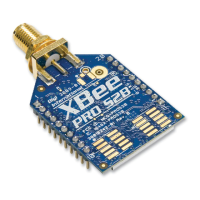XBee ZigBee networks Router operation
XBee/XBee-PRO ZigBee RF Modules User Guide 42
After startup, the coordinator will allow joining based on its NJ value.
Example: replacing a Coordinator (security disabled)
1 Read the OP, OI, CH, and ZS commands on the running coordinator.
2 Set the ID, SC, and ZS parameters on the new coordinator, followed by WR command to save these parameter
values.
3 Turn off the running coordinator.
4 Set the II parameter on the new coordinator to match the read OI value on the old coordinator.
5 Wait for the new coordinator to start (AI=0).
Router operation
Routers must discover and join a valid ZigBee network before they can participate in a ZigBee network. After a
router has joined a network, it can allow new devices to join the network. It can also route data packets and
communicate with other devices on the network.
Discovering ZigBee networks
To discover nearby ZigBee networks, the router performs a PAN (or active) scan, just like the coordinator does
when it starts a network. During the PAN scan, the router sends a beacon request (broadcast) transmission on the
first channel in its scan channels list. All nearby coordinators and routers operating on that channel (that are
already part of a ZigBee network) respond to the beacon request by sending a beacon back to the router. The
beacon contains information about the PAN the nearby device is on, including the PAN identifier (PAN ID), and
whether or not joining is allowed. The router evaluates each beacon received on the channel to determine if a
valid PAN is found. A router considers a PAN to be valid if the PAN:
Has a valid 64-bit PAN ID (PAN ID matches ID if ID > 0)
Has the correct stack profile (ZS command)
Is allowing joining.
If a valid PAN is not found, the router performs the PAN scan on the next channel in its scan channels list and
continues scanning until a valid network is found, or until all channels have been scanned. If all channels have
been scanned and a valid PAN was not discovered, all channels will be scanned again.
The ZigBee Alliance requires that certified solutions not send beacon request messages too frequently. To meet
certification requirements, the XBee firmware attempts 9 scans per minute for the first 5 minutes, and 3 scans per
minute thereafter. If a valid PAN is within range of a joining router, it should typically be discovered within a few
seconds.
Joining a network
Once the router discovers a valid network, it sends an association request to the device that sent a valid beacon
requesting a join on the ZigBee network. The device allowing the join then sends an association response frame
that either allows or denies the join.
When a router joins a network, it receives a 16-bit address from the device that allowed the join. The 16-bit
address is randomly selected by the device that allowed the join.

